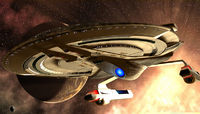Epsilon-Delta: Difference between revisions
EpsilonDelta (talk | contribs) |
EpsilonDelta (talk | contribs) |
||
| Line 176: | Line 176: | ||
Thus, her limited mobility in liquid environments must be compensated for within this existing design. This weight is compensated in liquid environments only through continuous use a single experimental anti-gravity module, that is extremely compact but energy-hungry. In summary, although Epsilon-Delta can remain afloat by continuously converting hydrogen into energy, she is still subject to the laws of conservation of energy. | Thus, her limited mobility in liquid environments must be compensated for within this existing design. This weight is compensated in liquid environments only through continuous use a single experimental anti-gravity module, that is extremely compact but energy-hungry. In summary, although Epsilon-Delta can remain afloat by continuously converting hydrogen into energy, she is still subject to the laws of conservation of energy. | ||
== | ==Extensible Emergency Safeguards== | ||
After the discovery of the Soong-type Android, [[ma:B4|B4]], and subsequent events surrounding the [[ma:Battle in the Bassen Rift|Battle in the Bassen Rift]] resulting in near-loss of U.S.S. Enterprise-E, a series of safety protocols were developed by Starfleet regarding the use of Soong-based technology. Like all sworn Starfleet Officers, Epsilon-Delta observes emergency protocols in ship or land battle-readiness and first aid but can assist with several additional safeguards. | After the discovery of the Soong-type Android, [[ma:B4|B4]], and subsequent events surrounding the [[ma:Battle in the Bassen Rift|Battle in the Bassen Rift]] resulting in near-loss of U.S.S. Enterprise-E, a series of safety protocols were developed by Starfleet regarding the use of Soong-based technology. Like all sworn Starfleet Officers, Epsilon-Delta observes emergency protocols in ship or land battle-readiness and first aid but can assist with several additional safeguards. | ||
Revision as of 04:50, 23 August 2009
| USS Discovery-B | ||
|---|---|---|
 DECOMMISSIONED | ||
| ||
|
|
Epsilon-Delta is a modified Soong-Type Android and the result of a joint-program commissioned by the Starfleet Intelligence, the Vulcan Science Academy and Starfleet Engineering Corps. Under the direction of Federation cyberneticist Helen Mirren, PhD, Epsilon-Delta continues to carry out the dual mission structure of the Epsilon Program, (1) to minimize risk and casualties in the course of Starfleet missions and (2) better understand interstellar social dynamics.
Starfleet Data & Physical Statistics
- Current Rank: Lt. Commander/Major
- Current Assignment: U.S.S. Discovery-B
- Position: Marine Officer, Platoon Leader
- Full Name: Epsilon-Delta
- Species: Soong-Type Android Modified Mark IV
- Date of Activation: December 1, 2358
- Place of Origin: Utopia Planitia, Mars
- Gender: Assigned as Female Stardate 238306.17
- Height: 5'7 1/2" (1.7145m)
- Weight: 200.75 lbs (.091 m.tons)
- Hair Color: Black (variable)
- Eye Color: Black (variable)
- Skin Tone: Pale (variable)
- Distinguishing Attributes:
With proper command clearance and during properly authorized emergencies, Epsilon-Delta may assume control of critical command computer systems without the use of any tactile or audio-visual interfaces.
Although she can directly communicate with most LCARS and no-nweapons-based Federation-compliant technology, Epsilon has stated in her internal log that she finds audio and tactile manipulation "stimulating."
Family
- Marital Status: Single
- Parents Helen Mirren, MD, PhD.
- Siblings
- Epsilon-Gamma: Mark III in the Epsilon series, designed for zero-gravity operation and as a single occupancy life-vessel in vacuum conditions. Deep Space 285, Avalon Sector.
- Epsilon-Beta: Mark II in the Epsilon series. Functional prototype in mothball. Location is classified.
- Epsilon-Alpha: Mark I in the Epsilon series. Functional prototype in mothball. Location is classified.
Epsilon-Delta Operational Log
Pre-Starfleet
- Information has been classified at the request of Dr. Helen Mirren, PhD.
Starfleet Life
- 238406.17 - Completes final cadet cruise at USS Centris.
- 238412.01 - Transferred to Utopia Planitia for further programming and hardware modification.
- 238406.17 - Promoted to Lt.JG and assigned as Chief of Operations, USS Discovery-B.
- 238502.06-238505.10 - Assisted in investigation of alien derelict in Avalon Sector and evacuation of Discovery-B following successful hijacking of Discovery-B by rogue Son'a agents. Delta encountered an ancient self-operating library which downloaded the contents of its database before destroying itself. [1]
- 238506.04 - Underwent refit at Deep Space 285 following extensive repair to mechanics. Positronic unit intact.
- 238506.15 - Encounters positive prediction error and re-experiences pre-Starfleet memory.
- 238507.22 - Assigned as Chief of Ops to USS Constitution-B while Discovery-B undergoes repair at Deep Space 285 .
- 238507.30 - Promoted to full Lieutenant with all rights and privileges.
- 238507.30 - 238510.05 Delta assists in mass evacuation of Genura III non-Federation colony in Avalon Sector.
- 238510.05 - Personality interaction routine is upgraded.
- 238603.15 - Promoted to Lt. Commander with all rights and privileges. Transfers to Marine Corps and rank of Major aboard USS Discovery-B. Awarded Merria Medallion[2] and Nebula Bar.[3]
Background
The Epsilon Program was jointly commissioned in 2372 by Starfleet Engineering Corps and the Vulcan Science Academy. Epsilon Delta's primary and secondary directives are (1) to minimize risks to civilians and Starfleet personnel and (2) better understand interstellar social dynamics. Much of the Epsilon series blueprint is classified under protection of Starfleet Intelligence but is accessible in this database with command level clearance.
Epsilon-Delta is the fourth model in the Epsilon series and the second of two functioning Epsilon units enlisted in active-duty in Starfleet.
Delta features breakthroughs in our understanding of new technologies acquired throughout the known galaxy during the last three decades. Modification to the Soong-based architecture includes security precautions designed to curtail the possibility of using the machine as a weapon against the Federation.
Briefing on Epsilon Program
(On stardate 238305.28, under extraordinary circumstances, Captain Tyr Waltas, CO, USS Discovery-B, directed Dr. Helen Mirren to disclose and declassify information relevant to Epsilon-Delta's origins. The following information was classified information from stardate 235812.01 until 238305.28.)
Although the Epsilon series is based on the work of Dr. Noonien Soong, the series' design is largely based on new findings following the return of the highly modified USS Voyager. Her operating system is a realization of new theoretical relationships between positronic theory and Borg technology as well as restricted research on eugenics theory and Terran DNA research.
Furthermore, the continued existence of the Epsilon program is based on a moral imperative to continually design and maintain mechanisms to support a synthetic organism [4][5]. This organism embodies a benevolent convergence of these technologies to serve the Epsilon Program's primary and secondary mission in Starfleet and to minimize casualties and better understand interstellar life.
The organism and its cybernetic technology were developed directly from projects culling data and ship schematics from the modified USS Voyager upon its return from the Delta quadrant, and its research contributions to the Borg Defense Initiative. Using a modification of the Soong-based design and research in synthetic organism, the Epsilon series is a life-support solution for an assimilated Borg individual whose connection to the collective has been effectively severed. The individual's consciousness is preserved within the Zimmerman/Barclay holographic operating system. Per Intelligence regulations, this highly sensitive information was protected from portable sensor equipment with an alloy designed for obfuscation.
The sensor-obfuscating alloy embedded into the Delta exo-skeletal structure is constructed of a quantum-based nanotechnology and successfully interferes with most sub-spatial signals, thus censoring bio-data that reveals the sythethic lifesign reading. The Epsilon-Delta holographic program is based on surgically salvaged memory engrams of the aforementioned individual in question and functions within the run-time environment of the Soong-Type positronic brain. The nanotechnology provides a foundation for the holographic signature and is supported by cybernetics that transact memory engrams between the synthetic neural structures and the positronic architecture.
Since the engrammatic data is non-biological, the positronic software can adapt to the holographic program designed to preserve these memory engrams. Aided by life support, the relationship is symbiotic, since new memory engrams in the synthetic architecture can die resulting in the loss of all memories not stored in the positronic architecture. In theory, this artificial intelligence structure simulates both cognitive and behaviorial psychology paradigms, producing data interpreted by some cyberneticists as emotion, self-awareness and a state of dream.
Unlike previous Soong-type Androids, the Epsilon series units are not recognized as sentient under Federation law; and have yet found a landmark case to prove their sentience. Until the event(s) whereby a legal precedent is presented in a tribunal or court requesting such evidence be provided as necessary to defend them as an innocent party, Epsilon-Delta's rights as a sentient remain in a state of legal purgatory.
It should be noted that the Epsilon-Delta program is aware of its own construction and that most Starfleet officers have access to this personal file. As part of her mission, and her expressed desire, Epsilon-Delta seeks to continually evolve healthy interpersonal relationships, stating it is essential to the integrity of her program to play multiple roles as a subordinate-ranking officer to commanding officer, a patient to doctor, and the case of Delta's designer, Dr. Helen Mirren, a child to a parent.
Profile on Dr. Helen Mirren, PhD
Early in her cybernetics career, Mirren initiated a variety of independent projects and conducted a period of research at the Omnicron Theta cybernetics research colony before it's demise in 2336. Dr. Mirren's reputation is well-known in the interstellar cybernetics community. She is one of the few living experts on Soong-type androids to have studied with Dr. Soong. She has publicly stated she refuses to work outside the Federation.
Mirren's family ties date back to Ancient Earth before the Eugenics Wars. She is an expert on cybernetics and a prominent historian whose thesis was on Khan Noonien Singh and the exploits of James Kirk and USS Enterprise-A. She is under unique entry restrictions when traveling within the Klingon empire. Since she is a special envoy, Starfleet has assigned her a security officer who doubles as her personal bodyguard should she be assigned to away missions. (See Alona Levine)
Dr. Mirren is the director of the Epsilon Program, a member of the Borg Defense Initiative and Project Voyager. She lives in the Avalon Sector, Deep Space 285.
Operation
Energy
All Epsilon units use various methods to store, draw and deplete energy, depending on environmental circumstances. Besides continually shunting kinetic energy into a storage battery, Epsilons can convert water and synthehol into energy and draw power from UVA/UVB radiation. Excess energy is usually sent to a reserve battery as well as the main battery which cycles energy between systems to maintain optimal efficiency.
It should be noted that Epsilon can share stored energy with compliant systems, such as tricorders, phasers and some mobile life-support systems.
In two improvised test scenarios, Epsilon was able to survive in desert climates and traverse great distances during daytime using abundant solar energy. Epsilon also used battery heat to liquify ice in Antarctic Earth, converting the water into hydrogen energy. Though Epsilon-Delta may continue to function well into the next century, test scenarios show that a total depletion of her energy reserves can be quickly accomplished through continuous unmanaged use.
Systems Extensibility
With proper command clearance and during properly authorized emergencies, Epsilon-Delta may assume control of critical command computer systems without the use of any tactile or audio-visual interfaces.
Although she can directly communicate with most scientific and non-weapons-based Federation-compliant technology, Epsilon has stated in her internal log that she finds audio and tactile manipulation "stimulating."
Theoretically, a starship's entire computer functions, including navigation, engineering and lifesupport, can be rerouted and controlled by the Epsilon positronic processor. However, this is an inefficient and unstable "miracle solution," as over a short period of time, information payload would gradually decrease processor efficiency.
Personality Interaction Routine & Psychology
Describing the nature of the "Epsilon matrix" is perhaps the most difficult section of this abbreviated primer. Theoretically, each of her decisions and actions are determined by her mission to explore while minimizing risks and casualties.
Although the architecture of Epsilon's personality is built on the Soong architecture, the Epsilon program's mission endeavors to improve the highly flexible interaction models Dr. Soong worked tirelessly to explore until the end of his life. Her psychological paradigm most closely mirrors those of humans and Vulcans.
As she negotiates the most efficient language (both verbal and non-verbal) needed to maintain peak operability, useful information is stored and rewritten and secondary non-essential data recompiled into engrammatic, encapsulated data and reanalyzed during non-critical periods of operation.
According to her internal logs and Epsilon Lab scientists, most of this interaction data is analyzed while off-duty. The reanalyzed experiences are sent via secure subspace networks but also positronically stored in her permanent memory.
Epsilon-Delta has shown an affinity for exploring holodecks and historical biographies from figures throughout the galaxy, and frequently interacted with holographic simulations.
Some scientists believe Delta also possess a fierce sense of loyalty, as evident in her voluntary assignment in the security and marine core division of her assigned vessel, USS Discovery-B.
Memory
In standard operating mode, Epsilon-Delta will consecutively record up to 500 petabytes of non-essential data. By default, storage capacity is prioritized for observational data relevant to crew behavior and mission success, then self-monitoring protocols, and lastly for monitoring external systems such as her assigned vessel's ship routines and crew logs. This data is uploaded via secure subspace to DS285.
Epsilons can self-erase any recorded information. Her short-term memory cycle prioritizes the protection of life over tasks devoted to memory operations, dumping non-essential data if necessary to the nearest subspace communicator, to relay to a subspace network, in the event of a catastrophe. This has proven useful in at least one mission scenario aboard USS Discovery-B, where an alien computer entity endeavored to break into systems to seize tactical information. [6]
Although she may serve as a highly valuable legal witness during security investigations, she must obey command orders to secure or classify mission scenarios.
Assigned Gender
Epsilon androids are built sex/gender neutral, although a physical anatomy may be "assigned" based on male/female ratios of a vessel/station assignment. However, this anatomy may have no bearing on the Delta series' sexual preference.
As of Stardate 238306.17, the Delta series was assigned as female. It should be noted that although functions required to establish a sexual relationship with the Delta series are untested, there is evidence it has already begun to evolve as part of the artificial lifesign interaction with the holographic matrix. Since Delta cannot reproduce in the normative biological sense, some cyberneticists theorize this routine is non-essential to the integrity of Delta's personality.
Dr. Mirren has stated that in the event of a sexual liaison, Delta will advise the initiating party of the potential dangers involved.
Sensor System
As Epsilon-Delta was designed to be deployed into exploratory mission scenarios, she is outfitted with a compact, but modular sensor and software package based on the last three decades of Federation research into matter, subspace and medical sensor technology.
The sensor apparatus is non-variable in range and extends to a diameter 12 meters from Epsilon's cranial module. It was designed as a navigational and exploratory system. The sensor system is capable of detecting subtle changes across distances and between obstacles, reading biosigns and environmental factors such as noise, light, heat and even data equivalent to the olafactory experience. The olafactory function was initially developed as a safety precaution against toxic airborne compounds.
Epsilon Delta employs pattern recognition software with sonar, the visible spectrum and infrared, as well as subdermal polymer sensitive to several thousand pressure points per millimeter. Epsilon's situational awareness works to continuously:
- relay information to Starfleet extrasensory sciences equipment;
- store information within an internal library;
- detect surrounding internal/external bio-signs
- cross-reference individual medical data with her peers' typical behavior;
- identify physical injuries and alert medical personnel to the presence of dangerous and/or contagious organisms;
- and in the presence of lethal weapons settings, Epsilon will raise ship/station security levels and alert security via a subspace modem. [7]
Epsilon has stated that her sensor system is crucial to her personality interaction routine. It allows her to "befriend" individuals based on her overall assessment of their personality and Starfleet record. [8] Some theorists speculate this is a "pro-active" subroutine independently developed in accordance with her secondary mission directive to explore interstellar social dynamics. Although some cyberneticists such as Whitehall argue it is a "positronic insurance policy" against uncertain away mission scenarios.
Materials and Vulnerability
Epsilon's design is a work in process. Her construction is a balance of synthetics, breakthroughs in cybernetics and an experiment in form and function and modifiable with proper authorization. Aboard USS Discovery-B, the Chief Medical Officer and Science Departments possess separately packaged critical data regarding cybernetic functions. And in accordance with regulations that the Chief Engineering Officer possess data on all on-board equipment, Epsilon's schematic is accessible by LCARS authorization.
Starfleet Engineering Corps rigorously pursued a design to fool-proof reverse engineering attempts on the Epsilon series, developing a semi-modular design scheme that "counters" unauthorized disassembly. Comprehensive analysis of hypothetical missions showed that the highest probability Epsilon-Delta would be damaged beyond repair would occur by intentional, premeditated subterfuge by a third party or a member of the Epsilon project to gain access to her positronic brain. With this analysis at hand, the Soong Architecture was modified with the primary intention to protect the positronic architecture at the expense of external hardware and cosmetics. Although it may sound counterintuitive, it is the deeper internal structure surrounding her cybernetic brain which has been designed for durability. Epsilon's stress limit on her arm, leg phlangic and vertebrate design is a programmatic rationale to remain out of harm's way.
External hardware
Computer and wired access is restricted by proprietary cabling whose design is classified and available only aboard USS Discovery-B and Epsilon Lab on DS285. Her external surface in contact with airborne environment is an organic, malleable compound designed to instantly become an adhesive and detour attempts as disassembly. Beneath this skin-like surface is a duranium shield that acts as a sensor-resistant material, making intelligent tampering difficult. This sensor-resistant duranium is also machined into a single-molding that surrounds the positronic unit.
Vulnerability Limits against Directed Energy Diffusion
The Delta series uses the same duranium-based alloys used to construct many types of Federation-compliant starships and Starfleet-grade housing. Over seventy percent of her construction is designed to withstand continuous stress and/or diffuse directed energy within the standard absorption rate of an industrial-grade warp-capable hull.
Although sturdy, Epsilon-Delta is not totally indestructible. She is vulnerable to long-term concentrations of ethereal or directed energy, including energy emitted from phasers, disruptor fire, quantum explosives or residual energy from matter/anti-matter collisions.
Water Survival
Epsilon is technically certified in water survival techniques and she can travel in water up to 2km/hour. However, her capacity to remain in high volumes of water exceeding her mass decreases exponentially over time. Most of Epsilon-Delta's solid mass is tonnage from duranium-based materials protecting her positronic brain.
Thus, her limited mobility in liquid environments must be compensated for within this existing design. This weight is compensated in liquid environments only through continuous use a single experimental anti-gravity module, that is extremely compact but energy-hungry. In summary, although Epsilon-Delta can remain afloat by continuously converting hydrogen into energy, she is still subject to the laws of conservation of energy.
Extensible Emergency Safeguards
After the discovery of the Soong-type Android, B4, and subsequent events surrounding the Battle in the Bassen Rift resulting in near-loss of U.S.S. Enterprise-E, a series of safety protocols were developed by Starfleet regarding the use of Soong-based technology. Like all sworn Starfleet Officers, Epsilon-Delta observes emergency protocols in ship or land battle-readiness and first aid but can assist with several additional safeguards.
The major emergency safeguards designed to prevent reverse engineering are explained below.
Safeguard to Deter Espionage: Epsilon-Delta's sensor systems continually scan for known weapons signatures and will silently raise condition levels via text or visual messages. In the event Epsilon detects her sensor systems have been tampered with, she will send an encrypted silent distress beacon to a Commanding Officer's communicator and/or nearest Security station.
Safeguard as Stand-alone Communications Server: All four Epsilon units were designed to serve as emergency beacons and mobile communications hubs in the event of an away-team or ship-board emergency and only where primary systems are rendered off-line. Epsilon can directly interface with all Federation-compliant communications systems and even act as a universal translator.
Safeguard to Self-Destruct to Prevent Control Override: The main battery can cycle energy for an explosive discharge roughly equivalent to the power of a fully-charged Mark IV phaser set to self-destruct. The collateral damage will effectively damage most internal hardware with the exception of the highly-shielded positronic brain and will destroy the synthetic organism. Since this safeguard results in the loss of the unit it can only be initiated through command authorization by either Dr. Mirren or the Commanding Officer of her assigned post.
Safeguard of Sudden Command Control of Hardware/Software: Although Epsilon units obey a rigid behaviorial code that values life, personal liberty and a greatest possible degree of security, command codes to directly control her behavior can be initiated in the event of an unprecedented critical situation. This command code authorization can only be initiated if her logic routine is compromised and only by her Commanding Officer. The encrypted voice authorization command is changed each stardate and housed in the LCARS [9] of her assigned vessel on as as well as the LCARS aboard Deep Space 285 and Utopia Planitia.
In the event Epsilon predicts she will incur catastrophic damage, Epsilon will execute a secure memory transfer by subspace to Deep Space 285, one of two Federation facilities where major repairs of her systems are possible.
Mission Archives
Up-to-date mission archives from Epsilon's internal log'


